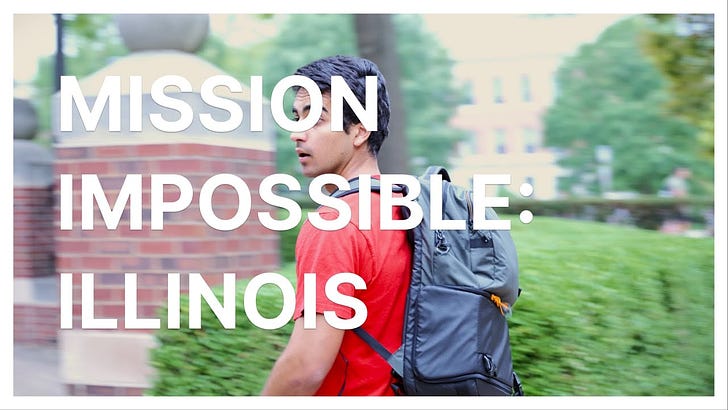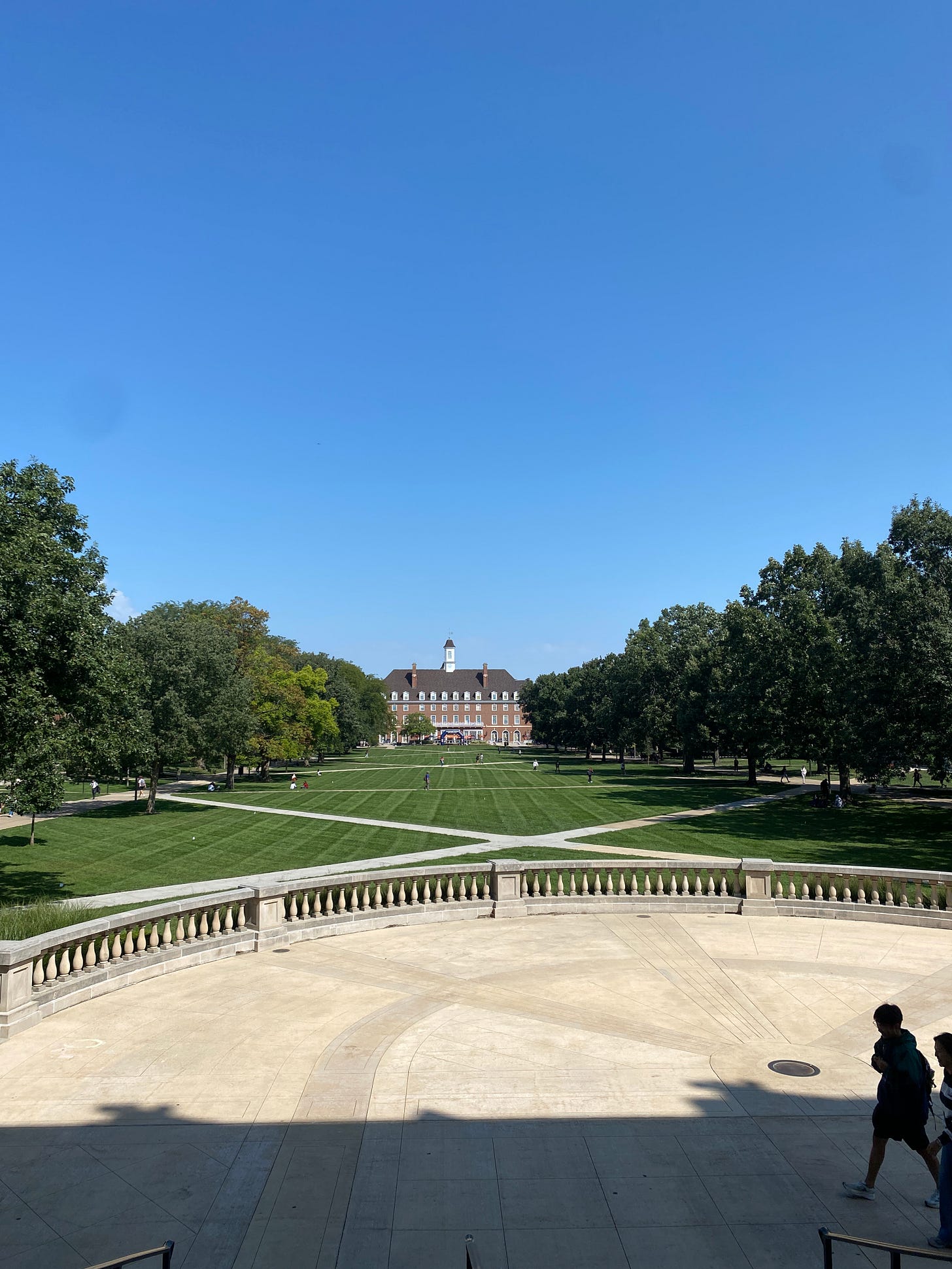Hi there,
It was Tuesday, October 3rd, at 8:40 p.m. when I received a text message from Aaryaman, “Let’s make a movie, man.”
In less than 24 hours, we managed to conceive the storyline, gather the actors, film the scenes, edit the footage, publish the movie, and distribute it.
This is the story of Mission Impossible @ Illinois, and the beginning of a larger project and interest: Telling captivating stories to provide new perspectives.
How you do anything is how you do everything because everything is one thing.
I do anything and everything with intensity.
“Intense” is the single word a high school friend chose when I asked him for a one-word description for my college applications
Yesterday, I headed to the soccer field, and as the game kicked off, it was all flair and finesse. Players were deftly dribbling, displaying cute tricks, but the rage of commitment was missing. There was a noticeable absence of that heart-thumping intensity, no one pushing themselves to the limit, and hardly a moment of panic where someone thought, "Oh shit, I better pass the ball."
In response, I turned the intensity up. I sprinted down the field as if my very existence depended on it and tackled opponents with the grit of a gladiator in the Colosseum. After, I netted three or four goals in quick succession. The opposite team had no option but to turn up their intensity. That's when the real thrill of the game began.
By the game's end, some were sporting bleeding scrapes and purple bruises, tongues were hanging out in exhaustion, and for those two intense hours, it felt as if our entire lives depended on winning that soccer match. But it all started with that initial and constant surge of intensity. The fervor didn't stop there, though. I was so charged up that I headed straight to the gym for another hour just to channel that energy. So much fun.
The best way to get to know someone is by observing how they do what they do because they’ll have the same attitude in their work, sports, life, or projects.
So, I received that text message on Tuesday night, and I replied, “Let’s make it.”
The night passed, and Wednesday dawned. We attended our classes, but halfway through the day, it hit me: “Why are we waiting? Let's actually create this movie.”
At 1:39 p.m., I messaged Aaryaman, asking, “Do you want to record something between now and your 4 p.m. class?”
Two minutes later, at 1:41 p.m., I received a response, “Let’s do it.”
By 2:15 p.m., we met up in the Main Quad.
But remember, this all began with a text message the day before. At this point, all we had was the desire to create this movie. We didn’t have actors, a storyline, or even a clear idea of where to start. Yet, that precious inspirational desire to do something is the only thing you need to get started.
First, what do we make the story about? We started tossing ideas into the air, sharing whatever came to mind, and offering feedback on what resonated with us. Many people mistakenly think that ideas arrive fully formed, but in reality, ideas are often like an artist's canvas waiting to be painted; they require construction and shaping.
Then, a moment of inspiration hit: What if we used music to set the tone and style for our movie? We grabbed our phones and began playing a variety of songs, ranging from classical and pop to Bollywood and cinematic soundtracks.
After listening to about twenty songs, Aaryaman suggested that the Mission Impossible Theme could be the basis for an intriguing film. As soon as he mentioned it, I recalled the single-shot filming technique that Aaryaman had introduced me to over the summer.
Single-take shots, also known as one-take scenes. They are long video sequences that feel like they have been shot in one take, i.e., without any no discontinuities or cuts. And there is something really magical about it.
One-take scenes feel a lot more immersive to the viewer. You stop being a distant observer and become someone who is a part of the video, following the characters as events unfold. You become more present in the actions of the event.
It’s approximately 2:32 p.m., we had the soundtrack and the filmmaking style.
But what about the idea and the actors?
Let's begin with the latter. Aaryaman and I were in the quad, openly discussing our ideas. If someone we knew happened to pass by, we'd stop them and ask if they could spare ten or fifteen minutes to be in a video. Fortunately, we found two friends who were not only willing but equally excited to join in.
Now, we almost have everything we need. But the question remains: what will this film be about?
One of us would toss an idea into the mix, and we'd collectively expand upon it, much like constructing a LEGO project. If it didn't quite feel right, we'd dismantle it and start again from different angles or levels.
That's how it unfolded. Someone suggested the idea of running, and then another person chimed in about a thrilling chase. Building upon those notions, someone else proposed, “As the person is running, there should be a villain or another pursuer on the main character's heels.”
There were specific elements we wanted to incorporate into this film. We aimed for it to be both surprising and exhilarating. The one-shot technique was the perfect way to inject that surprise factor, creating a heart-pounding chase scene.
But why is there a chase? What's the central conflict?
After a series of back-and-forths, with more steps forward than backward, we arrived at an idea that truly excited us: a one-shot chase scene infused with a surprising twist, set against the backdrop of the Mission Impossible Theme.
Sounds straightforward, right? Let's get to it.
It's now 2:49 p.m., and we're all set to begin shooting. Some of our actors need to leave by 3 p.m., giving us only ten minutes.
We take the first shot, but the scene unfolds on a completely different timeline. It might have been intriguing, but it didn't quite hit the mark.
So, we return to the beginning once more, and this time, I overlooked one of the pivotal moments in the film, and everything went wrong. Back to the start!
It's 2:57 p.m., and one of the actors has a class starting at 3 p.m. He really needed to leave, but we asked if he could stay for just one more shot. Thankfully, he agreed to stay for a few extra minutes.
We went back for one last take, and this time, everything went perfectly. After the shot, we expressed our gratitude to the actor so he could make it to his class, and our filming was wrapped up.
Phew, that was a close call.
With what we had captured, we were so thrilled that we even considered making another video. However, the weather had other plans, and the rain forced us to call it a day.
The rest of the day carried on, with everyone attending their respective classes and tending to their responsibilities.
Then, at 10:32 p.m., I received the final text message in this series, which contained a link.
It was the Mission Impossible @ Illinois video.
Ethan Hunt is on a mission to steal the forbidden key, a mysterious device that can set fire to all corn fields in Illinois.
He infiltrates the headquarters of the Syndicate, a rogue organization that wants to use the key for its own nefarious purposes. But things go wrong when he is discovered by their leader, Alexander Lane, who orders his men to capture Ethan and retrieve the key.
Ethan manages to escape with the key, but he is pursued by dozens of Syndicate agents who are armed and dangerous. He realizes he is on his own, and he has to find a way to deliver the key to a safe location before it falls into the wrong hands.
Will he succeed in his mission, or will he be caught by the Syndicate?
All we got was one shot, and with this project, we truly made it count.
This one-shot film marked the serious beginning of our journey in the art of telling stories to showcase new perspectives with surprise and ingenuity.
Writing is a way to tell stories, something we both know well. Through movies, we explore storytelling through a novel medium. Everything begins with a story; our aim is to enhance our ability to tell and share them with others.
Storytelling has the ability to shape perceptions, stir emotions, and ignite the fires of inspiration in the hearts of individuals. When narratives come to life, they can transcend time and culture, leaving a lasting impression on the human experience.
Think about the classic tales that have stood the test of time, like the timeless wisdom found in Aesop's Fables, or the universal themes of love, sacrifice, and redemption in stories like Romeo and Juliet. These narratives continue to resonate with people of all ages and backgrounds, imparting valuable life lessons and sparking deep contemplation.
Storytelling continues to evolve through various mediums, from the captivating narratives threaded on the pages of novels to the captivating worlds composed on the silver screen. The stories of superheroes like Spider-Man or Batman, for example, have become modern myths that inspire audiences to believe in the power of justice and the potential within themselves.
The impact and power of good storytelling are inspirational in their ability to illuminate the human spirit, initiate change, and connect us on a profound level. It reminds us that, as storytellers and as listeners, we are all participants in the narrative of life, capable of inspiring, transforming, and leaving an unforgettable mark on the world through the stories we share.
Our goal is to instigate ambition, encourage fearlessness, inspire people to discover their calling, and, most importantly, follow their curiosity.
In the words of Carl Sagan, “We make our world significant by the courage of our questions and the depth of our answers.” So, let me conclude with these adventurous questions:
How can we craft inspiring stories about the future?
What kinds of stories genuinely excite us?
How can we earnestly attempt to produce a full-fledged movie before May 2024?
Our intuition begins with a blurred vision, but you must have the courage to 1) confront the uncertainty of the outcome with determination and 2) have almost too much faith in yourself.
or
Ciao,
Juan David Campolargo







